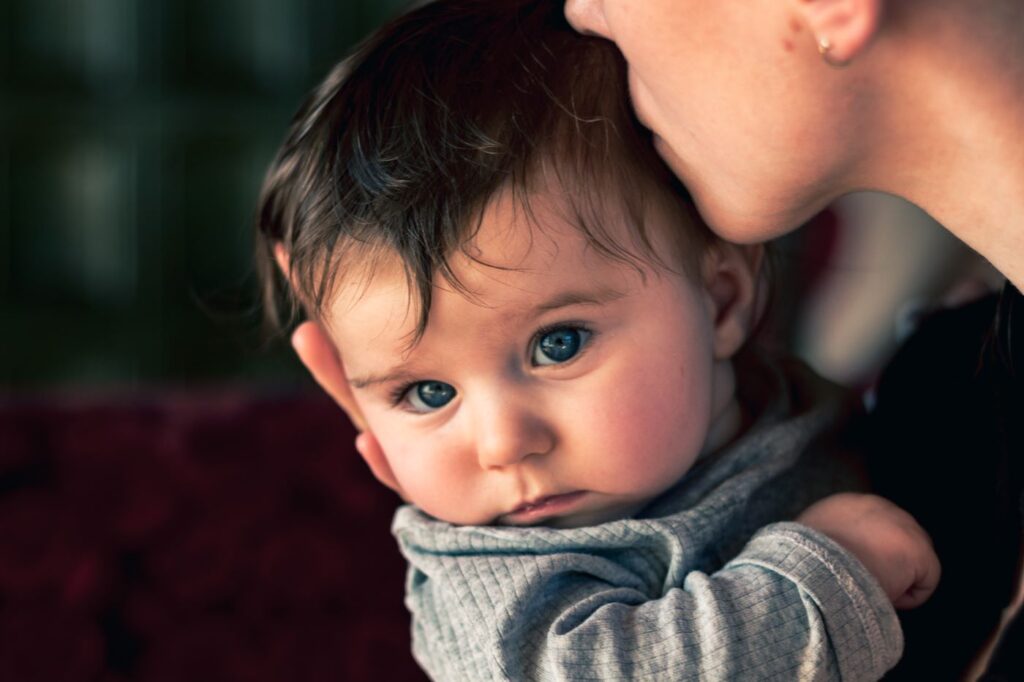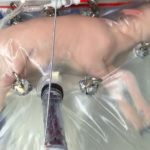The first time I walked into a Chinese orphanage, I picked up a little girl and held her close. At the time, I was working for a Chinese adoption agency, and while I was not yet a mother, I instinctively started rocking and swaying. Within a few minutes of making eye contact, the baby’s previously vacant expression blossomed into smiles and coos as I talked to her and mimicked her responses. Oddly, in a room of about 100 children arranged head-to-toe, two or three per crib, the baby I was holding was the only one making noise. After about five minutes, I put her down, ready to give attention to another abandoned soul.
The baby lost it.
The second her back touched the crib, her piercing cry tore through the quiet room, and I quickly scooped her up again. It slowly dawned on me that the children were quiet not because of an orderly schedule. They were crying because their cries had never been answered. So they stopped crying.
Without Mothers, Babies Suffer
Start your day with Public Discourse
Sign up and get our daily essays sent straight to your inbox.These abandoned children had given up hope that anyone would respond. They had no experience of a mother talking to them, soothing them with a song, or rocking them to sleep. The absence of human touch—maternal touch—had short-circuited their emotional wiring.
My orphanage story should sadden and horrify us all. We instinctively mourn when children are starved of their fundamental needs, especially when it comes to human contact. That’s certainly the case with the babies in the orphanage and others like them who may experience “delayed physical growth and brain development, dysregulation of the neuroendocrine systems, delayed cognitive development, and deviant attachment and/or attachment disorder” as a result. But it’s evident in lesser forms of human deprivation as well. The world is now being forced to acknowledge how even moderate human disconnection during COVID lockdowns damaged children’s long-term emotional, social, and developmental health, as well as academic success. Yet many eagerly anticipate an even more relationally barren existence during the most primal stage of development: the still-developing technology of artificial wombs.
Artificial Wombs, Mother Deprivation, and Commodification: A Deadly Combination
Artificial wombs are coming. You may remember the Matrix-esque “Ecto Life” video that made the rounds late last year. While factories for custom-ordered children are still in the realm of science fiction, they may not be for long. The technology has already had preliminary success with premature lambs. China is developing robot nannies who can “adjust the carbon dioxide, nutrition, and other environmental inputs” for children in artificial wombs once the technology becomes available. Conveniently, those AI “nannies” can also “rank” embryos and encourage or terminate their development according to an algorithm. Between now and then, we continue to fiddle with how children come to be through the trifurcation of motherhood via surrogacy and by dabbling in womb transplants for women (and possibly men as well).
Idealists out there think artificial wombs will cure a host of childbearing ills. Some, such as transhumanist Zoltan Istvan, see the advent of artificial wombs as the solution to the abortion debate. The woman doesn’t have to carry the unwanted baby, and the baby doesn’t have to die: a win-win, many think. Some hope the technology will help preemies achieve full-term development by transferring the underdeveloped fetus to a Biobag—problem solved. Others, as the Cato Institute recently suggested, envision artificial wombs as an option for “women to have biological children without the health risks, pain, or other physical and psychological inconveniences often attendant to pregnancy and childbirth.” Writers at Wired see the mechanizing of pregnancy as the great equalizer for sexual minorities, creating an “equal starting point for people of all sexes and genders.”
The advent of artificial gestation will result in some or all of those “solutions.” But a more realistic application of artificial wombs will be as a replacement for the most elusive component of the three-part—sperm, egg, womb—baby assembly process. #BigFertility is ever searching for available wombs, whether they are found in war-torn communities, among economically vulnerable women, or in countries where brown bodies are giving birth to white babies. It would be much easier, and much cheaper, if we could just cut women out of the gestating process completely.
Doubtless, the advent of artificial wombs will thrill all manner of adults: those who want their baby to gestate beyond the onset of preeclampsia, celebrities who prefer not to ruin their figures, career women who won’t step away from the office. Gone will be the days when gay couples must solicit a surrogate in their Buy Nothing Facebook group. And of course, traffickers, who will no longer need to extricate children from their parents through capital or capture, will love it.
Technologically Tinkering with Tots
How will children fare when coming into being totally starved of human touch? I would argue, far worse than the babies in the orphanage. The orphanage babies were, at least, as they were made to be, totally enveloped by their mothers’ warmth, voice, smell, song, language, sleep patterns, dietary preferences, and movement for the first 9 1/2 months of their existence. Only after the first stage of human development did they suffer what many adoptees refer to as a “primal wound,” the loss of the only relationship they had the moment they were born.
But babies grown in artificial wombs? Because humankind has never tinkered at this level with human development, outcomes for children gestated in a bag or by a bot are purely speculative at this point. What we do know, though, is that we have been technologically tinkering with children for decades now, and thus far, disrupting the natural processes of how children come to be has only diminished their physical, emotional, and relational health.
It began with creating babies in a petri dish, known as IVF or in vitro (in glass) fertilization in 1978. Now, around 2 percent of births in America and the UK are products of IVF. While there’s still much study to be done, we know that children made in a laboratory rather than begotten in the sexual embrace are at higher risk of premature birth, birth defects, cardiovascular issues, cancer, brain damage, and intellectual disabilities.
In addition to curating children in glass, the reproductive tech world has also introduced “third parties” into the baby-making equation. While the first “artificial impregnation” with foreign sperm took place within the womb in the late 1800s, the advent of IVF enabled baby-making using the gametes of strangers to be widespread. Children made from third-party eggs, which are extracted laparoscopically and only after weeks of hormone injections, arrived in 1983. The first child born to a “gestational surrogate,” who is not genetically related to the baby, was born in 1985.
Because there are few requirements for recordkeeping and sharing in the fertility industry, we don’t know how many children are born to sperm and egg “donation” each year. But the best estimate is 30,000–60,000 children born via a third-party sperm, and around 3,000 via a third-party egg annually.
What should be at the forefront of everyone’s mind is the question, “How does all this technological tinkering affect the kids?” We are only beginning to be able to answer that question. My work involves gathering stories of children who grew up in “modern” families, that is, children who had to lose a full or partial relationship with their mother or father to be in that family. Given the relatively early incorporation of sperm “donors” in the baby-making process, we have some information on children created via another man’s gametes, less from egg “donors,” and hardly any surrogate-born children both old enough and bold enough to speak out and/or participate in studies.
What Say the Kids?
So what do we know about “donor” kids? The largest study conducted (among very few) on outcomes for children of only sperm “donation” found that
young adults conceived through sperm donation are hurting more, are more confused, and feel more isolated from their families. They fare worse than their peers raised by biological parents on important outcomes such as depression, delinquency, and substance abuse. Nearly two-thirds agree, “My sperm donor is half of who I am.” Close to half are disturbed that money was involved in their conception.
The kids in this study had the benefit of being comforted and cradled by their mothers’ presence during gestation and a continuing bond and connection with her after birth. But listen to how the intentional loss of this child’s genetic father affected her sense of identity and starved her of the paternal love she craved:
I am the daughter (not biological) of two moms. I love them both sooo sooo much but there is not a day that goes by that i didn’t wish i had a dad. it is very hard for kids like me that are different. no matter how accepting society is. i have men in my life my moms’ friends but it is not the same. I love my parents but I don’t agree with the fact that I will never know half of my biology or my siblings. I will never do that to a child.
The data on children created via egg donation are even slimmer. The few studies we have focus only on early childhood and only reflect parents’ interview responses. But unsurprisingly, their stories reflect a similar craving for a relationship with their biological mother:
Every day I wonder about my biological mom. Does she wonder about me? Do we look similar? Do we have similar personalities, likes, and dislikes? Do I have half siblings? Do I have grandparents that know about me? That barely scratches the surface. I cannot put into words the pain of not knowing who my biological mother is and not being able to have/have had a relationship with her. I really do think about this at least once a day, and it is deeply mentally, emotionally, and psychologically troubling.
Even if a surrogate baby is genetically related to his two “intended parents,” on the day he’s born they are just two strangers among eight billion. For all he knows, the surrogate is his mother. Separation from one’s birth mother, even briefly, inflicts trauma on a child, imposes lasting psychological distress, and leads to that primal wound adoptees have been wrestling with for decades. Such wounds can manifest as depression, abandonment and loss issues, and emotional problems throughout an adoptee’s life.
While it may be decades before we can accurately measure outcomes for children created via surrogacy, we already know that the bond we form with our mothers in utero is not inconsequential. The handful of surrogate-born children who have been willing to speak up testify to that reality:
Children of surrogacy, just like children of a traditional adoption, deal with all the traumas that go along with adoption. We want to know where we come from. We want to know who our biological mothers are. We want to know who gave birth to us and what they are like. . . . When we have children in this world who already need homes, why are we intentionally creating children [via surrogacy] to go through adoption traumas?
The mother-child bond established in utero serves as the foundation for trust, attachment, and long-term relational health. So it’s hard for me to believe that the advent of artificial wombs, where babies will not just be separate from their birth mother—because there will be no birth mother—but starved of a mother altogether, will be anything but disastrous for children’s emotional well-being.
In addition to threats to their life and emotional health, cutting women out of the gestation process will spell a new kind of danger for children: a level of exploitation and abuse not yet imagined.
Never-Before-Seen Dangers to Children
Even in surrogacy, the “intended” parents often do not have the same level of connectedness and protectiveness as the unrelated woman carrying the child. There have already been cases in which the surrogate chooses to raise a disabled child abandoned by the intended parents: more specifically, these are cases of women who defied the requirement in their surrogacy contract by refusing to abort perfectly healthy babies when the intended parents demanded it.
In some cases, the only relationship preborn children have—their relationship with the surrogate mother—may be the only thing standing between life and death should the commissioning parents be dissatisfied with the child product.
And sometimes, even her pleading isn’t enough. Last year one surrogate begged the child’s two dads for an early delivery so she could start her cancer treatment. The men refused, unwilling to deal with the medical complexities of a preterm baby. And though the surrogate mother had lined up several couples willing to adopt the baby, the men didn’t want their DNA “out there.” The baby is now dead.
Mothers, even if they aren’t genetically related, form a protective bond with the children they carry. I don’t expect robot nannies to be so sentimental.
In addition to threats to their life and emotional health, cutting women out of the gestation process will spell a new kind of danger for children: a level of exploitation and abuse not yet imagined. Even with real women signing real surrogacy contracts, it can be difficult to distinguish surrogate pregnancies from child trafficking. Whereas adoption prohibits payment to the birth family—the bright red line distinguishing adoption from baby-buying—third-party reproduction and surrogacy are predicated on it. My Google “surrogacy” alert is filled with headlines of ring after ring after ring of traffickers busted for selling children under the guise of “family building.” Often, the only distinction between the two is the timing of the contract. Signed before conception? “Surrogacy.” Signed after conception? “Baby selling.” As if the timing of the contract will ameliorate a child’s identity struggles, primal wound, and mother hunger in any way.
Even without totally automated gestation, the commercial separation of children from their mothers via surrogacy has already allowed men to mass-produce surrogate babies, handed several children over to pedophile “intended parents” who never would have passed an adoption screening, and placed children with unstable men against the objections of the surrogate. Celebration and normalization of surrogacy among Kardashians, Kidmans, and Cohens of the world open the door for wider acceptance of manufactured babies that the predatory Adam Kings of the world are eager to walk through.
From the child’s perspective, separating gestation from parenting is risky. Separating gestation from humanity will be downright dangerous.
Children Hanging in the Balance
What will be the fate of children raised without any human contact in their first nine months of existence? Perhaps, like the thirteenth-century children of King Frederick’s experiment to discern what language they would speak if they were never touched or spoken to, children of artificial wombs will die.
If they don’t, and if these children voice their struggles, they, like many donor-conceived children today, may be asked if they’d rather not exist. But, just as in cases of rape, we can welcome and care for any new life created while simultaneously denouncing the circumstances of the child’s conception. A just response demands both. The children who result from reproductive technologies, including future artificial wombs, have dignity and worth and rights. That is the exact reason why we are critical of the way they came into being.
That first day at the orphanage, I didn’t hold any other baby. And when it was finally time to leave, I laid her down and nearly ran out of the room and down the hall so I wouldn’t have to hear her abandoned cry. It’s reasonable that children of artificial wombs will experience even greater suffering. Will they live? Will they be able to laugh or cry? Will they disappear into a trafficking underworld? A society concerned with protecting the rights and well-being of the most vulnerable will insist that not even one child will have to find out.
Image by Alexander and licensed via Adobe Stock.














